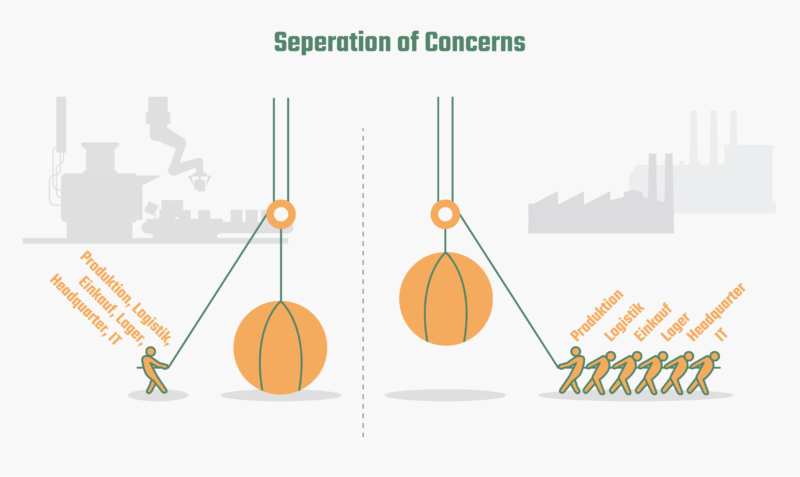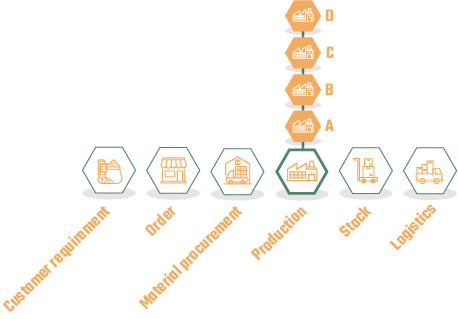Basic Concepts
This chapter explains the basic concepts that are required to understand and implement the architecture recommendations for the OPC Router. It provides an introduction to the key topics that are discussed in detail later in the manual.
The OPC Router as a central platform
The OPC Router is a central platform that enables communication between different industrial systems and devices. Its ability to seamlessly transfer and process data makes it a crucial part of the modern Industry 4.0 landscape. The platform supports various protocols and standards, ensuring a high level of flexibility and interoperability.
Key features of the OPC Router
- Protocol support: Support for OPC UA, MQTT, REST, databases, SAP and many other protocols.
- Data integration: Integration of data from various sources such as PLCs, databases, IoT devices and cloud services.
- Visualization and monitoring: Real-time monitoring and visualization of data streams and connections.
- Automation: Automation of processes through rule- and event-based workflows.
Fundamentals of Scalability: Vertical and Horizontal
In the context of operating the OPC Router, both vertical and horizontal scaling are crucial to meeting the requirements of different company sizes. Here is a more detailed look at both scaling approaches in the specific context of OPC Router operation.
Vertical scaling
Definition: Vertical scaling (scale-up) refers to increasing the capacity of a single server or instance by adding more resources such as CPU, RAM or storage.
Use cases: Vertical scaling is particularly suitable for smaller installations or scenarios in which higher performance per instance is required. This could be the case if a single OPC Router processes a large number of data points or performs complex data processing tasks.
Advantages of vertical scaling
- Easy to implement: Does not require any changes to the existing application architecture.
- Low complexity: Since only one instance needs to be managed, administration and configuration are easier.
- Immediate performance improvement: Adding resources can immediately improve performance.
Challenges of vertical scaling
- Limited scalability: The capacity of a single server has physical limits.
- Single point of failure: If the only instance fails, this can lead to downtime.
Example: A medium-sized company operates a production hall with an OPC Router that collects data from all machines. By adding more RAM and CPU capacity, the processing speed and the amount of data that can be processed can be increased without the need for an additional instance.
Horizontal scaling
Definition: Scale-out means adding additional servers or instances to distribute the load and increase capacity.
Use cases: Ideal for larger installations or scenarios where high availability and load balancing are required. This is particularly useful in large production environments or distributed locations.
Advantages of horizontal scaling
- Virtually unlimited scalability: Capacity can be expanded almost indefinitely by adding more instances.
- Improved fault tolerance: Redundancy allows individual instances to fail without affecting the overall system.
- Flexibility: New instances can be easily added or removed to respond to changing requirements.
Challenges of horizontal scaling
- Increased administrative effort: Multiple instances must be managed and monitored.
Example: A large company operates several production halls and locations. By setting up multiple OPC Router instances for each production hall or location, data processing can be performed locally, thus distributing the load and increasing system reliability. If necessary, additional instances can be added to expand capacity.
Practical implementation
Vertical scaling
- Resource analysis: Determine current resource requirements and identify bottlenecks.
- Upgrade: Add additional CPU, RAM or storage to the existing OPC Router instance.
- Monitoring: Monitor performance after the upgrade to ensure that the expected improvements are realized.
Horizontal scaling
- Needs analysis: Analyze the load and identify areas that would benefit from an additional instance.
- Instance deployment: Set up additional OPC Router instances, configure them and connect them to the existing network.
- Load balancing: Export the project components from the existing OPC Router instance that are to be transferred to the additional instance.
- Commissioning: Import the exported project components into the new instance, deactivate the connections in the original instance. Switch the new instance to productive mode and verify that the new instance has been successfully integrated.
- Monitoring and maintenance: Monitor the performance of all instances and perform regular maintenance.
Separation of Concerns in the OPC Router
Definition and significance of SoC
Separation of Concerns (SoC) is an architectural principle that aims to clearly separate different responsibilities and tasks within a system. This leads to a clearer structure and more efficient operation of the systems.
In the context of the OPC Router, this means that the various “concerns” or responsibilities within an OPC Router instance are grouped and separated so that there are no dependencies. This makes extensions and scaling much easier.

How SoC is applied in the OPC Router
Modularization of the “concerns”
- Individual instances for different responsibilities: In an OPC Router architecture, different responsibilities, such as the connection of different production areas or plants, should be combined in separate instances. This means that each instance of the OPC Router is responsible for a specific task or area.
- Example: One instance could be responsible for communicating with the machines in hall A, while another instance processes the data from hall B.
Benefits of separating concerns
- Easier extensions: When a new plant, hall or location is introduced, another OPC Router instance with the same or similar configuration can simply be added. This reduces the effort and complexity of extending the system.
- Scalability: The clear separation of responsibilities means that the individual instances can be scaled independently of each other. If requirements in one area increase, only the corresponding instance needs to be expanded.
- Independent updates: Security, software and configuration updates can be carried out more easily and in a more targeted manner. Since the instances are separate from each other, updates can be carried out without affecting multiple production departments or processes at the same time.
- Isolation of errors: Problems in one instance (e.g. hardware errors or software crashes) do not affect the other instances. This increases the overall stability and reliability of the system.
Practical implementation
Setting up separate instances
- Planning: Start by planning which areas or tasks should be separated. Identify the main responsibilities and distribute them to separate instances.
- Implementation: Set up the instances of the OPC Router according to the planned distribution. Make sure that each instance has the necessary connections and configurations to fulfill its specific tasks.
- Maintenance and monitoring: Monitor the instances regularly and perform any necessary maintenance work. Use the separation of the instances to make targeted updates and improvements.
Example of an architecture
- Instance 1: Responsible for machine control and data collection in hall A.
- Instance 2: Responsible for quality control and inventory management in hall B.
- Instance 3: Responsible for energy monitoring and environmental controls throughout the plant.

Summary
Understanding the basic concepts of vertical and horizontal scaling, as well as the principle of separation of concerns, is crucial for the successful implementation and use of the OPC Router in different company sizes. While vertical scaling offers a simple solution for smaller use cases, horizontal scaling enables almost unlimited expansion and higher reliability. Separation of concerns helps to reduce complexity and increase system efficiency. The following chapters will explore these concepts in more detail and present practical examples of their application.